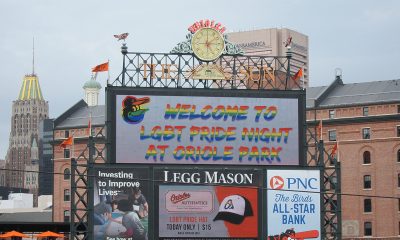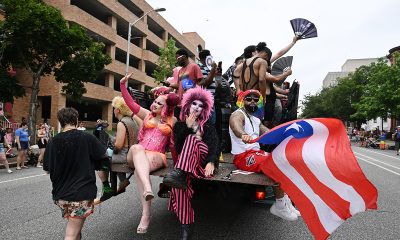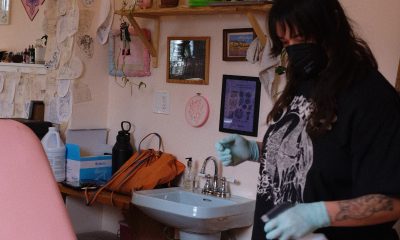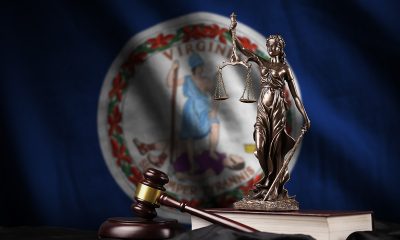Books
John Waters talks about his debut novel, ‘Liarmouth: A Feel-Bad Romance’
Nationwide book tour kicks off in D.C.
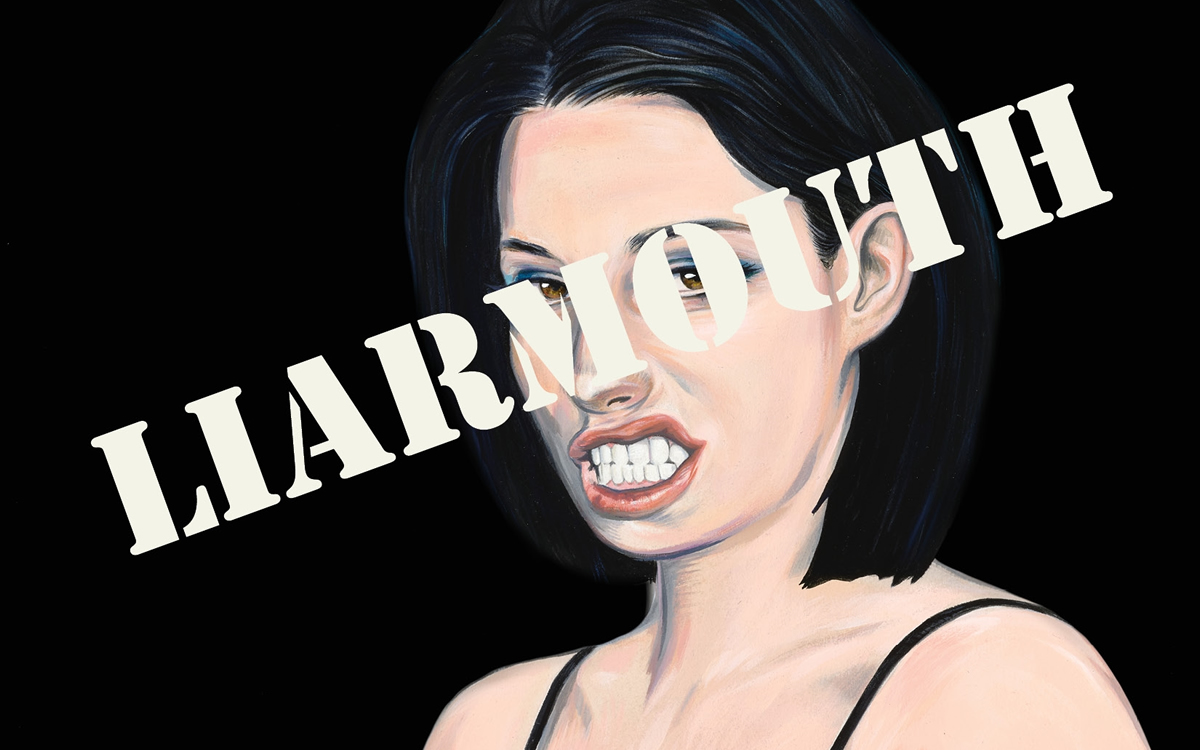
John Waters has directed movies; written non-fiction; given spoken-word performances; made visual art; modeled for fashion designers, even lent his voice to a country music video. After reaching his 70s, he added a new occupation: Novelist.
The result, after three years of writing, is “Liarmouth: A Feel-Bad Romance,” published last month by Farrar, Straus and Giroux. It follows Marsha Sprinkle, a woman who steals suitcases at the airport; her mother Adora, who performs plastic surgery on pets; Marsha’s daughter Poppy, the head of a band of renegade trampoline bouncers; Marsha’s partner-in-crime, Daryl, and Daryl’s talking penis, Richard.
Set in Baltimore and points north, Liarmouth is what fans of John Waters might expect from him and yet different from anything he’s done before. As the title implies, it’s filled with stories and situations that seem hard to believe but may be just a few years away from happening, such as facelifts on pets. It also gives Waters a chance to write about sexual kinks including erotic tickling and ear masturbation.
To promote his debut novel, Waters, 76, launched a coast-to-coast book tour that began in Washington, D.C. at Politics and Prose Bookstore, where he was interviewed by Baltimore-based writer and columnist Marion Winik. The following transcript of their conversation has been condensed and edited.
Marion Winik: John, this is your debut novel, and the convention is that a debut novel is usually highly autographical, a version of the author’s coming of age. Is this true of Liarmouth?
John Waters: No. I think I am every character in it. When you write a novel, you live with those people. You become those people. I read it aloud to make sure I don’t say the same word over and over and everything.
Q: Is there one character you identify with more than the others?
A: Well, Marsha, only because I love to have villains that are the heroines in my book. I think Marsha Sprinkle would get along with Francine Fishpaw. She would get along with Serial Mom. She would get along with all of them. But she’s a loathsome person. She does terrible things. She loves to lie. Lying gives her power. It makes her feel prettier. She does even practice lies. You know, just to get in shape, like going to the gym. She’s a contemptible person, really. She only eats crackers because she never wants to defecate. She finds that repellent. She just shoots out little pellets. She doesn’t have to wipe, even.
Q:This leads to my next question. I picture a book group, for example, the book club at the Baltimore Museum of Art, which is mostly ladies from Guilford, discussing this book. And I picture them asking the question: Is poop really this funny?
A: Well, she learns to have a proper bowel movement, later, through love. She has a fudge dragon. That’s one that won’t even flush. You asked me. But anyway, this is a tiny portion of the book.
Q: Not too tiny.
A: And Anne Tyler read this book. That was my favorite. Anne’s my friend and I said to her, “Oh, you poor thing. You have to read this book.”
Q: In comparing your films to this novel, I realized that you’re in fact a magical realist much like Gabriel Garcia Marquez or Isabel Allende. And while I suppose CGI [computer generated imagery] could create a film equivalent for Richard the Talking Penis, I would argue that Richard has a life on the page that he could not have in film. Do you agree? Did you find that you could do things in fiction that you can’t do in any other medium?
A: Certainly you can. Because I don’t have to worry about the budget. If this were a movie, it would be NC-17, which would make it not get made, and it would also have a huge special effects budget, because there’s all this insane trampolining going on and bouncing and everything, and Daryl does have a talking penis. Now, there are talking penises in a lot of books. But in mine, his penis turns gay while he’s straight and it’s a battle. So could that become a movie? Sure. But somebody has to buy the rights from me to make it. That’s even funnier.
Q: Maybe Pixar. Going into the fudge dragon situation.
A: I thought I was trying to get away from that.
Q: The entire group of people is heading up to Provincetown for something called The Analingus Festival.
A: She’s giving the plot away. But it’s not so hard to imagine that in Provincetown they would have an Analingus Festival. They have Gay Pilots’ Week. They have Lesbian Crafts Week. They have Gay Family Week. They have Bear Week.They have every kind of obscure thing. So Analingus Week, maybe this book will make that happen. They could have children with face-painting, like, anuses, and Rimmer Bingo. Make it a real theme.
Q: Back to trampolines: Marsha has a daughter that’s alienated from her and has gotten involved with a movement. It’s kind of an identity, sort of like LGBTQIA+, but this one is trampolines.
A: She’s been shut down, from a trampoline accident at her Bouncy-Bouncy place.
Q: In the book, ‘trampoline’ is standing in for many, many different identities. It gets to be the occasion to make many, many woke jokes, but the woke jokes are all about trampolines.
A: They have to bounce. Their car bounces when they’re in airports. They live on waterbeds so they can bounce. They only eat food that bounces.
Q: Where did this come from? Why trampolines?
A: I don’t know. I just thought of it. I read about trampoline parks and then I went to one. I know they get shut down because of accidents and stuff, so I tried to imagine a cult where it was like a speakeasy where she opens illegally, and these [trampoline people] — they call them Tramps – hang out and there are other Tramps and they see each other around. There are all these people that are going like this all the time and they can’t keep still, or they get depressed. So they keep bouncing more and more and they get higher and then they learn to do other things, like shake sideways and roll and all different spiritual things.
But once they learn these powers, they realize that there are drawbacks. There are side effects. So I believe, in a novel, once you set up this world, no matter how crazy it is, there are rules in that world and you have to respect it, no matter how crazy it is. So even if there’s something that’s completely impossible to happen, as long as the logic of the novel that you set up follows it, it’s like having a continuity person in a movie. Copy editors do that. They go through with you and they say, ‘Well, how could this be?’ It doesn’t matter how could it be. Nobody jumps up in the air and stays up there. But still, if you believe in that happening, then there’s a certain logic that has to continue through the whole thing. Now, this book, I make fun of narrative. Like, 40 things happen in every sentence. If in four days, all this happened to any one person, they would be dead from exhaustion.
Q: But then they’d be at the Analingus Festival, so everything would be great. Back in the 1970s, Abbie Hoffman wrote Steal This Book and taught thousands of people how to make free long-distance phone calls and wring a profit from American Express travelers checks.
A: I did both of those things. You’d buy $500 worth of travelers checks. Your friend would go. They’d look the same. He’d report them stolen and I’d report them, and then we’d split it. You could cash them. One cashes the other’s.
Q: Aren’t you worried that your book is going to spawn a lookalike baggage claim theft [wave]?
A: Well, it is easy. To me, the security in airports after 9-11, it completely changed where you couldn’t do anything. Except the one thing they did was stop checking luggage tags. They used to [check tags], in every airport when you came in. Now they don’t. And it gave me the idea because I was with my friend Pat Moran once and we were leaving the airport and this man was chasing us up the escalator: “You’ve got my bag!” They do all look alike. So even if you get caught, you can say, “Oh, I’m sorry, I thought [it was mine].” And [Marsha] has a fake chauffeur with her so it even looks more real.
And there’s another thing. I know somebody that steals flight attendants’ pocketbooks when they get on a plane, because they’re always in the same place. So I do tell that. And my friend, when she did it, her friend was with her and she didn’t know and then they said, “All right. Someone took the flight attendant’s pocketbook. No one’s getting off this plane.” Like school. And she didn’t snitch, and the plane eventually took off. So I’ve heard of some of these things, but I exaggerated. I’m in a plane almost every day, touring with my shows and everything. So I’m doing research the whole time — how women always put their pocketbook in first and how you can get things when they come out of the X-ray.
An easy way to steal — the Baltimore airport has not done anything about this, but in the [bathroom] stalls, always, the hook for your coat, people reach right over and grab your bag and run. So, many airports have lowered it. Baltimore has not yet. You can still do that. When someone’s on the toilet, they just reach over and grab your coat or your bag when it’s on the hook. You’d have to pull your pants up to chase them. They’re out of there.
Q: You have to do a book-signing at BWI [airport.] As far as social commentary goes in this book, there’s plenty. It’s not just the trampolines. There’s Marsha’s mother. Tell us a little about Marsha’s mother.
A: Her mother does facelifts on pets, illegally. Then the dog has a problem and thinks he’s a cat. So he’s trapped in a cat’s body. It like species change.
Q: He’s transitioning.\
A: It’s complicated. It is. But I don’t think animal plastic surgery is too far in the future. I can imagine it in Beverly Hills, I really can, where they try to get the cat to look like Joan Rivers, that wind tunnel look. But [Adora] has her own plastic surgery. She makes her belly button an outie, not an innie, because she’s repelled by nature catching things in her. She’s obsessed by nature’s garbage can, her belly button.
Q: I feel like the whole country is full of people who can’t make a joke about anything. I mean, God forbid we would talk about a dog who wants to transition to being a cat, or the people with the trampoline not being able to express their identity. I am wondering, how are you getting to make these jokes?
A: Well, because I don’t think they’re mean. I make fun of the rules in my own community that I live in, the community I love. I’m a bleeding-heart liberal. I say I’m an Antifa sympathizer who’s too old to run from the tear gas. But we made fun of ourselves, with Abbie Hoffman and that crowd. That’s the only thing the trigger-warning crowd doesn’t [do.] They don’t make fun of themselves, and they need to a little, you know? So I’m making fun of something I love, but I don’t think I’m mean-spirited.
I did a show this week and the first question that really threw me was: How did you avoid cancer? I quit smoking. But what they really said was: How did you avoid getting cancelled?… If I fear censorship today, it would not be from the right. It would be from maybe the left. A rich kid in school. I agree with what they’re saying. I just don’t agree with the self-righteousness about it. Make fun of yourself. I made fun of everything. Johnny Depp made of himself. That’s why he was in Cry-Baby. Patty Hearst made fun of being a victim by being in a movie. Traci Lords made fun of being in porn by playing a bad girl. If you make fun of what you’re trying to do, then you can work, because humor is what works. Humor is what gets people to listen, not standing up and badgering, saying you can’t do this.
Q: I think you are cancel-proof.
A: No, I don’t think I am. And I think you have to be very careful. There is now a sensitivity editor, a word I can barely say out loud, [in publishing.] My friend Bruce Wagner’s whole book stopped because of sensitivity editors. They go through the book. We sent [Liarmouth] to a sensitivity editor and they refused to call back. Even my editor didn’t know what to do with that, so we just went on. I did read through it with my editor, my agent, and I have three really smart women who work for me who are three generations and are really good copy editors and we went through it. And if anything was touchy today, we went even further liberal the other way to make it funnier.
Q: What’s an example of that?
A: Well, in the first part, there’s this bus accident and this one couple is trapped in their seats but they were Asians. Which was fine, but then during [the writing], there was Asian violence, so we can’t have that. Marsha is proud that all of her victims are diverse. And whenever I introduce a character, I say ‘a white man,’ because I read once that all writers, if someone is white they never say that but if it’s a black person, the first time it comes up they say ‘a black person.’ So I try to put, if it’s a white person, I say that. I get that race is the most touchy thing. But I wanted to have every race in the book. The Asian couple we changed to Italian American and that wasn’t offensive. Why? Because it’s the news. So I tried to make fun of that but embracing it by trying to be even overly politically correct while making fun of it.
Q: I think it’s inspiring and leading the way, to show that we can still laugh about these things and there still can be jokes about them.
A: Racism isn’t funny. I say that in my [spoken word] show, that basically Black Lives Matter is the most effective [movement] since Martin Luther King. But I wish Jet magazine, which I used to get and love, would come back and have it be a hip kind of magazine for [black readers[ that makes fun of white reaction to it. This black friend in Baltimore told me that a guy at work said to her, what’s your tracking number, your bank? She said, “For what?” He said, “I want to send you something.” He sent her $50. She said, “What’s this for?” He said, “You know.” Slavery? No wonder there’s rage out there. Fifty bucks? Like that’s going to make up for it. I thought thatJet magazine could be like Spy magazine, only to make fun of white liberals’ reactions to Black Lives Matter.
Q: That’s a really good idea. Are you going to write another novel?
A: I hope so…The reviews so far have been good. But I don’t know yet…The best thing that could happen to this book is if the Florida governor bans it.
Question from the audience: Why a novel now, at 76?
A: Well, it’s not that big a stretch because I’ve written15 movies. They’re fiction. In Carsick, the book where I hitchhiked across the country, the first two thirds of the book I made up as the worst rides I could get and the best, like in fiction. And then I wrote about the real way it happened. That was easy. I was in it. But [why now?] To do it. To challenge myself. The same reason I hitchhiked across the country at 66, why I took LSD when I was 70, for the first time in 50 years. Just to challenge myself. I don’t know. What am I going to do when I’m 80? Turn straight? That’d be a stunt. Old chickens make good soup.
The Blade may receive commissions from qualifying purchases made via this post.
Books
Embracing the chaos can be part of the fun
‘Make Sure You Die Screaming’ offers many twists and turns
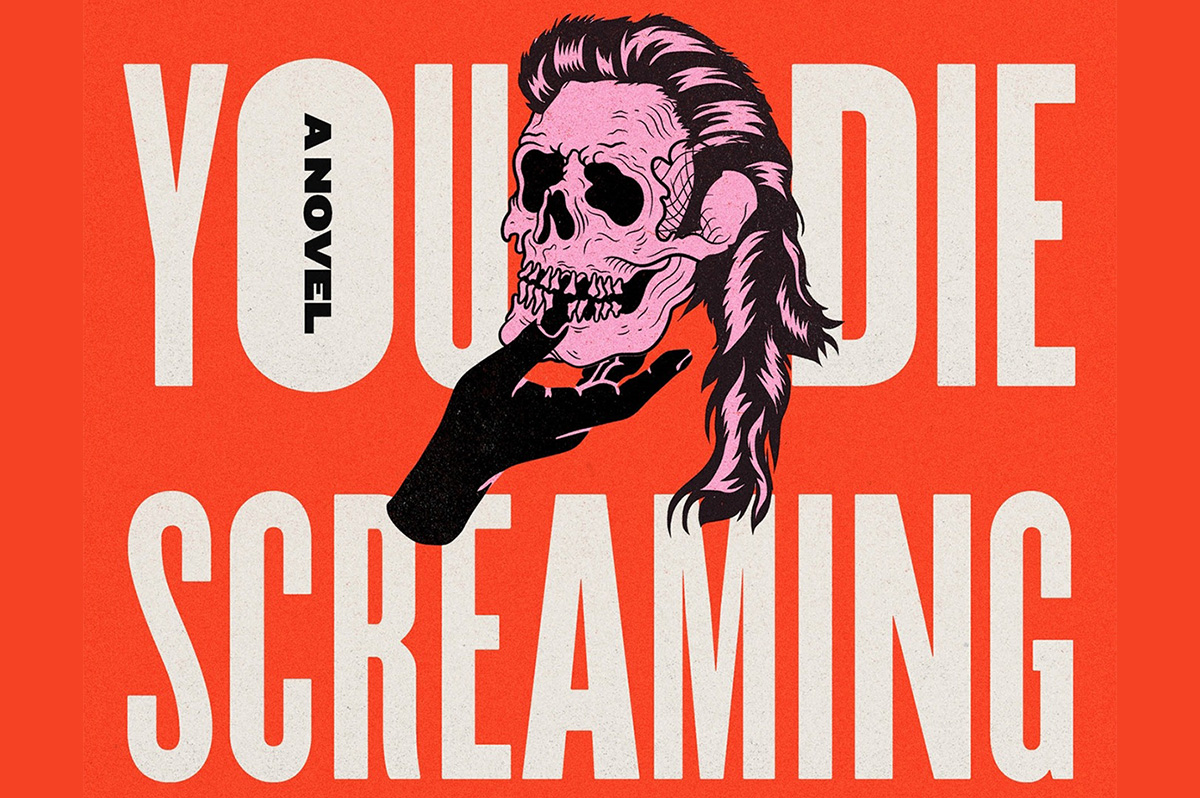
‘Make Sure You Die Screaming’
By Zee Carlstrom
c.2025, Random House
$28/304 pages
Sometimes, you just want to shut the door and forget what’s on the other side.
You could just wipe it from your memory, like it didn’t occur. Or create an alternate universe where bad things never happen to you and where, as in the new novel “Make Sure You Die Screaming” by Zee Carlstrom, you can pretend not to care.

Their mother called them “Holden,” but they’d stopped using that name and they hadn’t decided what to use now. What do you call an alcoholic, queer, pessimistic former ad executive who’s also “The World’s First Honest White Man,” although they no longer identify as a man? It’s a conundrum that they’ll have to figure out soon because a cop’s been following them almost since they left Chicago with Yivi, their psychic new best friend.
Until yesterday, they’d been sleeping on a futon in some lady’s basement, drinking whatever Yivi mixed, and trying not to think about Jenny. They killed Jenny, they’re sure of it. And that’s one reason why it’s prudent to freak out about the cop.
The other reason is that the car they’re driving was stolen from their ex-boyfriend who probably doesn’t know it’s gone yet.
This road trip wasn’t exactly well-planned. Their mother called, saying they were needed in Arkansas to find their father, who’d gone missing so, against their better judgment, they packed as much alcohol as Yivi could find and headed south. Their dad had always been unique, a cruel man, abusive, intractable; he suffered from PTSD, and probably another half-dozen acronyms, the doctors were never sure. They didn’t want to find him, but their mother called…
It was probably for the best; Yivi claimed that a drug dealer was chasing her, and leaving Chicago seemed like a good thing.
They wanted a drink more than anything. Except maybe not more than they wanted to escape thoughts of their old life, of Jenny and her death. And the more miles that passed, the closer they came to the end of the road.
If you think there’s a real possibility that “Make Sure You Die Screaming” might run off the rails a time or three, you’re right. It’s really out there, but not always in a bad way. Reading it, in fact, is like squatting down in a wet, stinky alley just after the trash collector has come: it’s filthy, dank, and profanity-filled. Then again, it’s also absurd and dark and philosophical, highly enjoyable but also satisfying and a little disturbing; Palahniuk-like but less metaphoric.
That’s a stew that works and author Zee Carlstrom stirs it well, with characters who are sardonic and witty while fighting the feeling that they’re unredeemable losers – which they’re not, and that becomes obvious.
You’ll see that all the way to one of the weirdest endings ever.
Readers who can withstand this book’s utter confusion by remembering that chaos is half the point will enjoy taking the road trip inside “Make Sure You Die Screaming.”
Just buckle up tight. Then shut the door, and read.
The Blade may receive commissions from qualifying purchases made via this post.
Books
Two new books on dining out LGBTQ-style
Visit nightclubs, hamburger joints, and a bathhouse that feeds customers
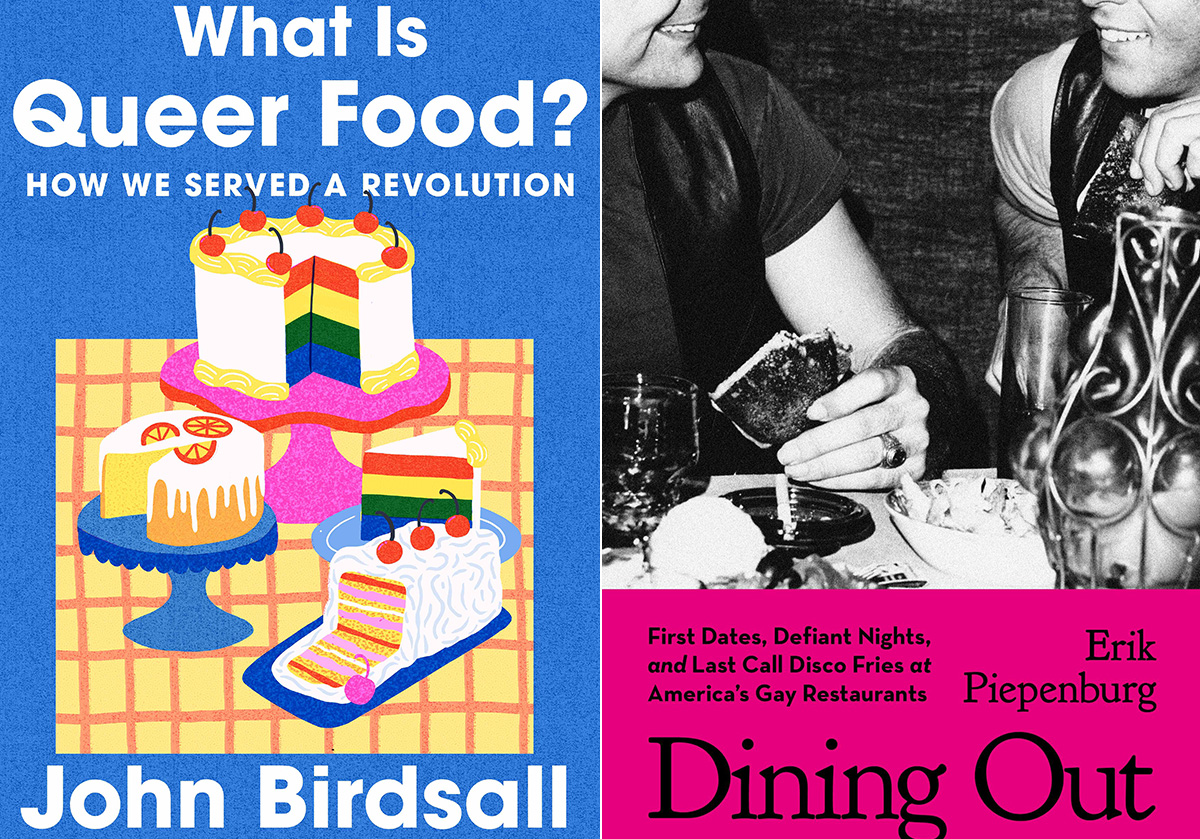
‘What is Queer Food? How We Served a Revolution’
By John Birdsall
c.2025, W.W. Norton
$29.99/304 pages
‘Dining Out: First Dates, Defiant Nights, and Last Call Disco Fries at America’s Gay Restaurants’
By Erik Piepenburg
c.2025, Grand Central
$30/352 pages
You thought a long time about who sits where.
Compatibility is key for a good dinner party, so place cards were the first consideration; you have at least one left-hander on your guest list, and you figured his comfort into your seating chart. You want the conversation to flow, which is music to your ears. And you did a good job but, as you’ll see with these two great books on dining LGBTQ-style, it’s sometimes not who sits where, but whose recipes were used.
When you first pick up “What is Queer Food?” by John Birdsall, you might miss the subtitle: “How We Served a Revolution.” It’s that second part that’s important.

Starting with a basic gay and lesbian history of America, Birdsall shows how influential and (in)famous 20th century queer folk set aside the cruelty and discrimination they received, in order to live their lives. They couldn’t speak about those things, he says, but they “sat down together” and they ate.
That suggested “a queer common purpose,” says Birdsall. “This is how who we are, dahling, This is how we feed our own. This is how we stay alive.”
Readers who love to cook, bake or entertain, collect cookbooks, or use a fork will want this book. Its stories are nicely served, they’re addicting, and they may send you in search of cookbooks you didn’t know existed.
Sometimes, though, you don’t want to be stuck in the kitchen, you want someone else to bring the grub. “Dining Out” by Erik Piepenburg is an often-nostalgic, lively look at LGBTQ-friendly places to grab a meal – both now and in the past.

In his introduction, Piepenburg admits that he’s a journalist, “not a historian or an academic,” which colors this book, but not negatively. Indeed, his journeys to “gay restaurants” – even his generous and wide-ranging definitions of the term – happily influence how he presents his narrative about eateries and other establishments that have fed protesters, nourished budding romances, and offered audacious inclusion.
Here, there are modern tales of drag lunches and lesbian-friendly automats that offered “cheap food” nearly a century ago. You’ll visit nightclubs, hamburger joints, and a bathhouse that feeds customers on holidays. Stepping back, you’ll read about AIDS activism at gay-friendly establishments, and mostly gay neighborhood watering holes. Go underground at a basement bar; keep tripping and meet proprietors, managers, customers and performers. Then take a peek into the future, as Piepenburg sees it.
The locales profiled in “Dining Out” may surprise you because of where they can be found; some of the hot-spots practically beg for a road trip.
After reading this book, you’ll feel welcome at any of them.
If these books don’t shed enough light on queer food, then head to your favorite bookstore or library and ask for help finding more. The booksellers and librarians there will put cookbooks and history books directly in your hands, and they’ll help you find more on the history and culture of the food you eat. Grab them and you’ll agree, they’re pretty tasty reads.
The Blade may receive commissions from qualifying purchases made via this post.
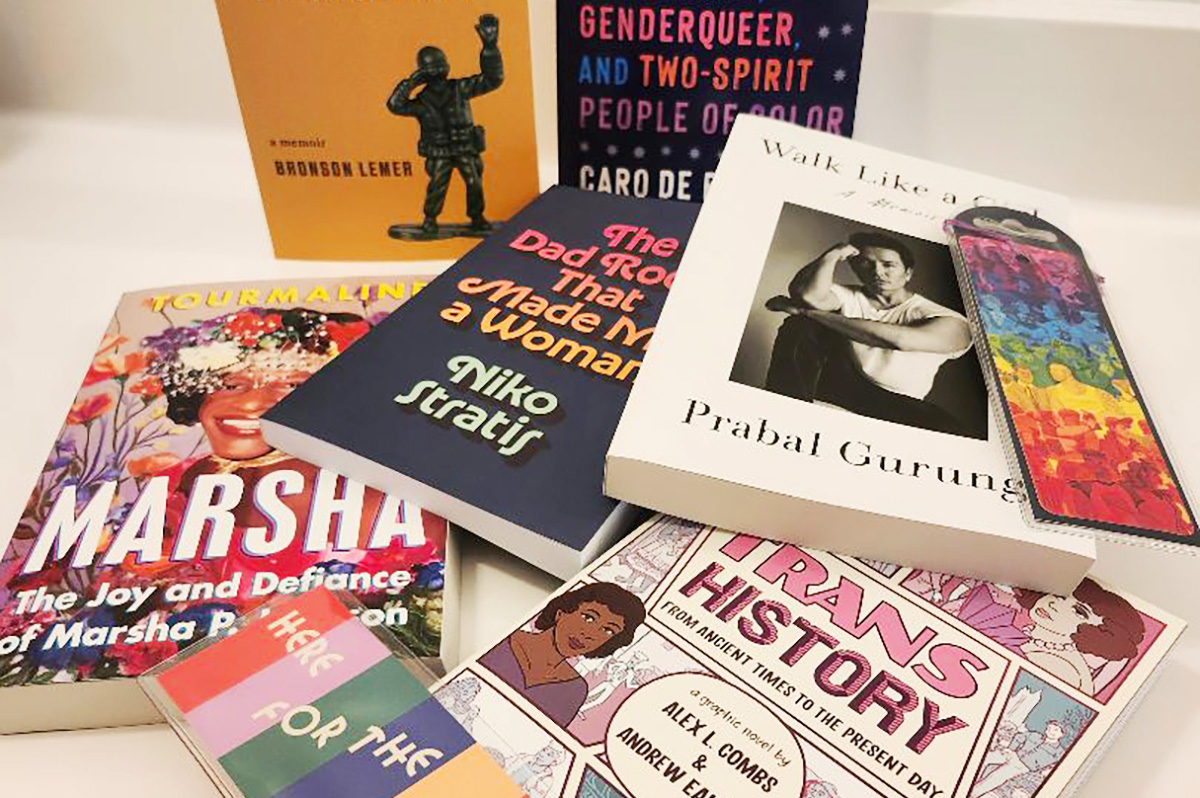
You’re going to be on your feet a lot this month.
Marching in parades, dancing in the streets, standing up for people in your community. But you’re also likely to have some time to rest and reflect – and with these great new books, to read.
First, dip into a biography with “Marsha: The Joy and Defiance of Marsha P. Johnson” by Tourmaline (Tiny Rep Books, $30), a nice look at an icon who, rumor has it, threw the brick that started a revolution. It’s a lively tale about Marsha P. Johnson, her life, her activism before Stonewall and afterward. Reading this interesting and highly researched history is a great way to spend some time during Pride month.
For the reader who can’t live without music, try “The Dad Rock That Made Me a Woman” by Niko Stratis (University of Texas Press, $27.95), the story of being trans, searching for your place in the world, and finding it in a certain comfortable genre of music. Also look for “The Lonely Veteran’s Guide to Companionship” by Bronson Lemer (University of Wisconsin Press, $19.95), a collection of essays that make up a memoir of this and that, of being queer, basic training, teaching overseas, influential books, and life.
If you still have room for one more memoir, try “Walk Like a Girl” by Prabal Gurung (Viking, $32.00). It’s the story of one queer boy’s childhood in India and Nepal, and the intolerance he experienced as a child, which caused him to dream of New York and the life he imagined there. As you can imagine, dreams and reality collided but nonetheless, Gurung stayed, persevered, and eventually became an award-winning fashion designer, highly sought by fashion icons and lovers of haute couture. This is an inspiring tale that you shouldn’t miss.
No Pride celebration is complete without a history book or two.
In “Trans History: From Ancient Times to the Present Day” by Alex L. Combs & Andrew Eakett ($24.99, Candlewick Press), you’ll see that being trans is something that’s as old as humanity. One nice part about this book: it’s in graphic novel form, so it’s lighter to read but still informative. Lastly, try “So Many Stars: An Oral History of Trans, Nonbinary, Genderqueer, and Two-Spirit People of Color” by Caro De Robertis (Algonquin Books of Chapel Hill. $32.00) a collection of thoughts, observations, and truths from over a dozen people who share their stories. As an “oral history,” you’ll be glad to know that each page is full of mini-segments you can dip into anywhere, read from cover to cover, double-back and read again. It’s that kind of book.
And if these six books aren’t enough, if they don’t quite fit what you crave now, be sure to ask your favorite bookseller or librarian for help. There are literally tens of thousands of books that are perfect for Pride month and beyond. They’ll be able to determine what you’re looking for, and they’ll put it directly in your hands. So stand up. March. And then sit and read.

